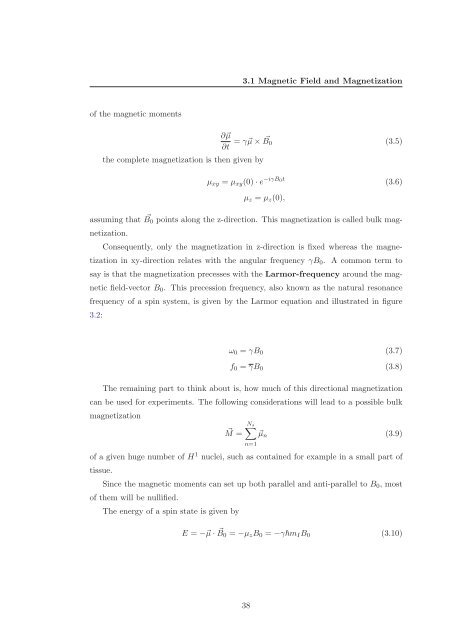Master's Thesis - Studierstube Augmented Reality Project - Graz ...
Master's Thesis - Studierstube Augmented Reality Project - Graz ...
Master's Thesis - Studierstube Augmented Reality Project - Graz ...
You also want an ePaper? Increase the reach of your titles
YUMPU automatically turns print PDFs into web optimized ePapers that Google loves.
3.1 Magnetic Field and Magnetization<br />
of the magnetic moments<br />
the complete magnetization is then given by<br />
∂⃗µ<br />
∂t = γ⃗µ × ⃗ B 0 (3.5)<br />
µ xy = µ xy (0) · e −iγB 0t<br />
(3.6)<br />
µ z = µ z (0),<br />
assuming that B ⃗ 0 points along the z-direction. This magnetization is called bulk magnetization.<br />
Consequently, only the magnetization in z-direction is fixed whereas the magnetization<br />
in xy-direction relates with the angular frequency γB 0 . A common term to<br />
say is that the magnetization precesses with the Larmor-frequency around the magnetic<br />
field-vector B 0 . This precession frequency, also known as the natural resonance<br />
frequency of a spin system, is given by the Larmor equation and illustrated in figure<br />
3.2:<br />
ω 0 = γB 0 (3.7)<br />
f 0 = γB 0 (3.8)<br />
The remaining part to think about is, how much of this directional magnetization<br />
can be used for experiments. The following considerations will lead to a possible bulk<br />
magnetization<br />
∑N s<br />
⃗M = ⃗µ n (3.9)<br />
n=1<br />
of a given huge number of H 1 nuclei, such as contained for example in a small part of<br />
tissue.<br />
Since the magnetic moments can set up both parallel and anti-parallel to B 0 , most<br />
of them will be nullified.<br />
The energy of a spin state is given by<br />
E = −⃗µ · ⃗B 0 = −µ z B 0 = −γm I B 0 (3.10)<br />
38





